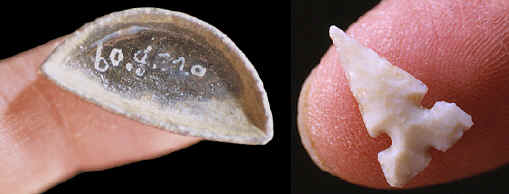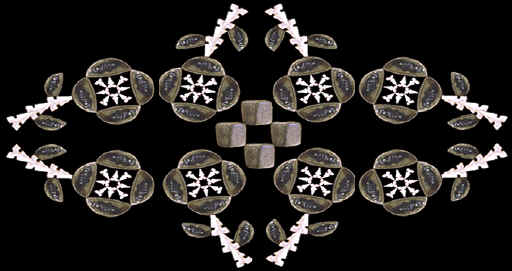|
"Even children do not have games, but
eagerly and enthusiastically participate in the activities of the
adults. The principal toy is the bow, but this is employed in hunting
birds."---1946,
Willard Z. Park, Handbook of South American Indians, Vol. 2, Tribes of
the Sierra Nevada De Santa Marta, Columbia, p. 884.
"The children were buried with their toys of
which are excellent miniatures of regular pottery".---1946,
Rafael Larco Hoyle, Handbook of South American Indians, Vol. 2, A
Culture Sequence From The North Coast of Peru, pp. 168-169.
"Boys play
with toy canoes, bows, arrows, and the like, and girls with dolls; there
are no group games. Every child is taught adult tasks."---1948,
Julian Steward & Alfred Metraux, Handbook of South American Indians,
Vol. 2, Tribes of the Peruvian and Ecuadorian Montana, p.584.
"Boys
have toy hunting outfits, with models of sleds, kayaks, and umiaks, and
small bows and arrows for hunting birds. The girls play with dolls made
of ivory or other material, and also have small models of dishes and
other women's household utensils."---1899,
Edward William Nelson, "The Eskimo About Bering Strait," p.
331

MINIATURES
& TOYS
NORTH & SOUTH AMERICA
Toys have been around for as long as children have been around, at least
Homo sapiens children. The earliest toys were probably represented by
natural things like sticks, stones, shells or bones. There are at least
three different categories of toys. One group is represented by items
that attract and sooth infants, like rattles or pieces of cloth. Another
category of toys are the ones invented by the children for their own
use. A third category of toys are the ones made by adults for
educational purposes. These would be in the form of smaller versions of
everyday items used in the household to cook food, hunt animals or raise
infants, such as miniature clay pots, bows & arrows, dolls and
cradles.
|
|
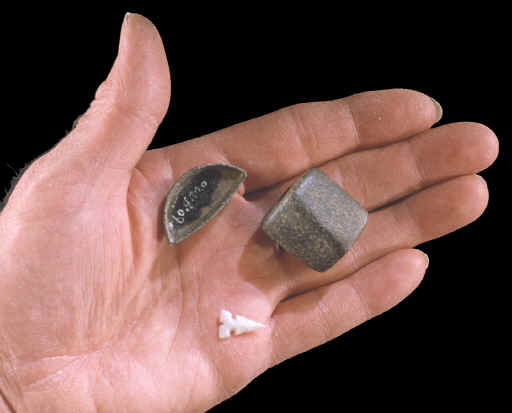
CLICK ON
PICTURE FOR LARGE IMAGE
MINIATURE LAMP,
BANNER-STONE & CAHOKIA POINT
ALASKA, ILLINOIS AND
MISSOURI
The miniature artifacts pictured here cover a time span of several
thousand years. The people who made the Cahokia point and the
banner-stone are no longer represented by living cultures. But,
because of their miniature size, the point may have once been hafted
onto a small bow and arrow set. The banner-stone may also have been attached to a
child's version of a spear thrower (atlatl). The
Eskimo oil lamp comes from a living culture where Anthropologists
have been able to observe their use as toys. The smallest item, the
Cahokia point, measures 5/8 of an inch (1.2 cm) long. The oil lamp
is made of steatite, the banner-stone is made of granite and the
Cahokia point is made of Burlington chert. |
|
|
Some native American Indians, like the Eskimo
in the north and the Pueblo
cultures in the southwest, are well represented by a
large variety of toys. But toys or miniatures from the eastern U.S. are
not so well represented. One reason they are fairly rare is that most
toys were probably made of organic materials like wood or bone. Except
for stone arrow points that take little time to make, it's
much easier to manufacture something from softer materials. The frozen country
in the north and the dry warm climate in the southwest are areas
friendly to artifact preservation and these are the areas where most
toys have been preserved in collections.
|
|
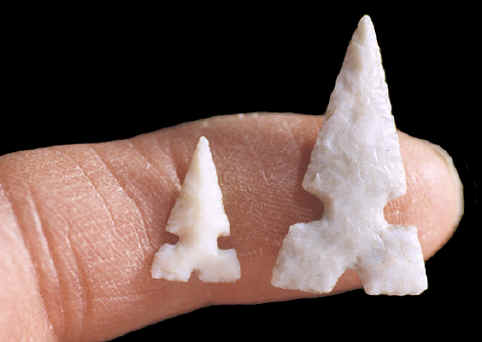
MINIATURE &
NORMAL SIZE CAHOKIA POINT
CAHOKIA MOUNDS SITE
MADISON & ST. CLAIR COUNTIES, ILLINOIS
These two triple-notched Cahokia points were found many years ago on
the Cahokia Mounds site. They are very good representative examples
for the type. The larger point is normal for size, even though it's
extremely well made. But the other point is far smaller than any of
the many different types of Cahokia points. The care that was taken
to make it suggests that it was something special. It's also not a
resharpened point but it was originally made as a miniature. A
logical guess is that it was once mounted on the end of a miniature
arrow for a child. Many cultures from Alaska to South America have
been observed teaching their children the use of bows and arrows
with miniature sets. Both of these points were made from Burlington
chert. The larger point measures 1 3/16 inches (3 cm) long and the
smaller measures 5/8 of an inch (1.2 cm) long. |
|
|
In North America the earliest toys would have belonged to
Clovis culture children. But there are no artifacts from this period that
are officially recognized as toys. The only artifacts that might be a
candidate are very tiny Clovis points. The example illustrated in this
article was found on the Blackwater Draw Locality 1 site in New Mexico.
It measures only 1 1/8 inches (2.8 cm) long and it seems to be to small
for a normal size spear or dart point. This example is probably not the
smallest one ever made, so there must also be smaller ones. This miniature
Clovis point may have been attached to the end of a child's spear or
dart point. It may have even been attached to the end of an arrow.
Without organic materials from this time period (especially wood), it's difficult to know,
for sure, how all the different sizes of Clovis points were propelled through
the air.
|
|
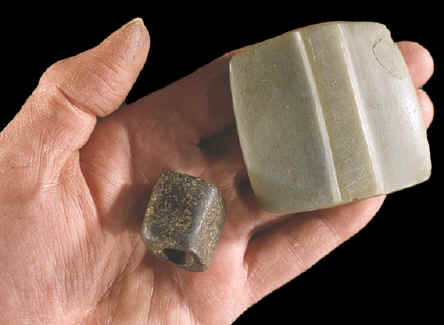
MINIATURE &
NORMAL SIZE BANNER-STONES
LATE ARCHAIC PERIOD
GEORGIA AND MISSOURI
The two banner-stones pictured here illustrate a miniature next to a
more normal size banner-stone. The small one would definitely fall
within the miniature category. It's a rare example because late
Archaic craftsman were not traditionally making them, at least not
out of stone. Maybe they were making them out of wood rather than
stone. For a child, it may not have mattered. But for whatever the
reason, this one was made exceptionally small which suggests that it
was used as a toy.
Banner-stones were used as weights on spear
throwing sticks called atlatls. The small banner-stone pictured here
was found by Terry Annin near Festus, Missouri. It's made of granite
and measures 1 1/16 of an inch (2.6 cm) long. The larger one is a
cast of a banner-stone that was excavated many years ago by Dr.
Lewis Larson at the Sapelo Island Shell Ring site in McIntoch
County, Georgia. It's was made from a fine grained semi-translucent
green quartzite and measures 2 3/8 inches (6 cm) long. |
|
|
In the eastern United States, the Archaic people left
behind a few rare examples of miniatures in the form of grooved axes,
banner-stones and other items. Although there have been large numbers of
miniatures made in recent years, there are a few
that were made anciently. Tiny grooved axes may have been
attached to small handles, making them ideal toys for children. On the
other hand, it's difficult to say if any of the small ungrooved axes
(celts) were toys. They could be mounted on the ends of
handles and used as chisels. This article illustrates a tiny
banner-stone that was found by Terry Annin near Festus, Missouri. It's
much smaller than any normal size banner-stone. One obvious explanation
for its small size is that it was intended for a child. Instead of a
miniature bow and arrow set, the Archaic child would have had a
miniature spear (dart) and spear thrower (atlatl). This banner-stone is made of granite and measures 1 1/16 of
an inch (2.6 cm) long.
|
|
CONTINUE ON TO PAGE
TWO
|
|
"REFERENCES"
1899,
Nelson, Edward William "The Eskimo About Bering Strait," Bureau
of American Ethnology, 18th Annual Report, p. 331
1912, Hodge, Frederick Webb, "Handbook of American Indians, North
of Mexico," Toys, p. 797.
1946, Park, Willard Z. "Tribes of the Sierra Nevada De Santa
Marta, Columbia," Handbook of South American Indians, Vol. 2,
p. 884.
1946, Rafael Larco Hoyle, "A Culture Sequence From The North
Coast of Peru," Handbook of South American Indians, Vol. 2,
pp. 168-169.
1948, Steward, Julian & Metraux, Alfred, Tribes of the Peruvian
and Ecuadorian Montana, Handbook of South American Indians, Vol. 3,
p.584.
|
|
RECENT
LISTINGS HOME
ORDERING |
